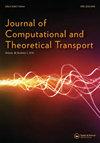Gray Phonon Transport Prediction of Thermal Conductivity in Lithium Aluminate with Higher-Order Finite Elements on Meshes with Curved Surfaces
IF 1.1
4区 工程技术
Q3 MATHEMATICS, APPLIED
Journal of Computational and Theoretical Transport
Pub Date : 2021-03-18
DOI:10.1080/23324309.2021.1900258
引用次数: 2
Abstract
Abstract We present a method for predicting thermal conductivity by deterministically solving the Boltzmann transport equation for gray phonons by utilizing arbitrary higher-order continuous finite elements on meshes which may also be unstructured and utilize curved surfaces. The self-adjoint angular flux (SAAF) formulation of the gray, steady-state, single relaxation time, phonon radiative transport (PRT) equation was spatially discretized using the continuous finite element method and angularly discretized using the discrete ordinates method. The solution discretization methodology was verified using a method of manufactured solution (MMS) spatial convergence test case and compared favorably to previous work. The angular phonon radiances, heat flux, and temperatures computed in this work compare favorably to previous literature in silicon thin films. Using local values of the temperature gradient and heat flux, the thermal conductivity as a function of position in a one-dimensional perfect crystal was evaluated using a Fourier’s Law representation and compared to kinetic theory. Our results show that in the interior of the simulation domain, our transport-based prediction of thermal conductivity converged on the kinetic theory estimation. We also find that near isothermal boundaries, the transport solution deviated from kinetic theory, implying non-equilibrium behavior in the thin-film limit and agreed with previous studies.曲面网格上铝酸锂热导率的高阶有限元灰色声子输运预测
摘要本文提出了一种利用任意高阶连续有限元在非结构化网格和曲面上确定性地求解灰色声子的玻尔兹曼输运方程来预测热导率的方法。用连续有限元法对灰色、稳态、单松弛时间声子辐射输运(PRT)方程的自伴随角通量(SAAF)公式进行空间离散,用离散坐标法对其进行角离散。通过制造解(MMS)空间收敛测试案例验证了解离散化方法,并与以往的工作进行了比较。在这项工作中计算的角声子辐射,热流和温度与以前的硅薄膜文献相比是有利的。利用温度梯度和热通量的局域值,利用傅里叶定律的表示对一维完美晶体中的导热系数作为位置的函数进行了评估,并与动力学理论进行了比较。我们的结果表明,在模拟域的内部,我们基于输运的热导率预测收敛于动力学估计。我们还发现,在等温边界附近,输运解偏离了动力学理论,表明在薄膜极限下存在非平衡行为,这与前人的研究结果一致。
本文章由计算机程序翻译,如有差异,请以英文原文为准。
求助全文
约1分钟内获得全文
求助全文
来源期刊

Journal of Computational and Theoretical Transport
Mathematics-Mathematical Physics
CiteScore
1.30
自引率
0.00%
发文量
15
期刊介绍:
Emphasizing computational methods and theoretical studies, this unique journal invites articles on neutral-particle transport, kinetic theory, radiative transfer, charged-particle transport, and macroscopic transport phenomena. In addition, the journal encourages articles on uncertainty quantification related to these fields. Offering a range of information and research methodologies unavailable elsewhere, Journal of Computational and Theoretical Transport brings together closely related mathematical concepts and techniques to encourage a productive, interdisciplinary exchange of ideas.
 求助内容:
求助内容: 应助结果提醒方式:
应助结果提醒方式:


